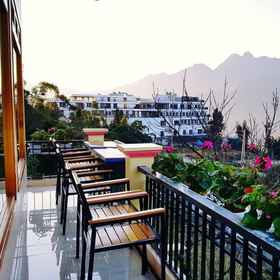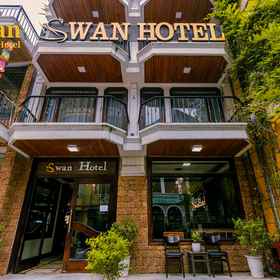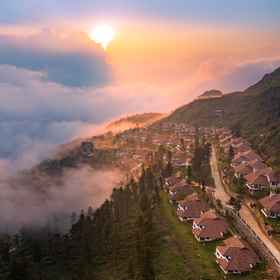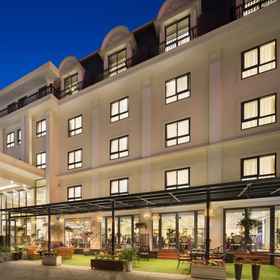
Hotels in Sa Pa
- Hotel/
- Vietnam(17443 Hotels)/
- Lao Cai Province(430 Hotels)/
- Sa Pa(368 Hotels)
Destinations to Discover






Why Pay More
When You Can Pay Less?

Popular Hotels in Sa Pa

Discover what you like
Stay near exciting spots
Plenty of options, whatever your occasion
Đăng ký để sử dụng coupon
Giảm ngay 50K
8% giảm giá Khách sạn
8% giảm Hoạt động Du lịch
12% giảm Đưa đón sân bay
10% giảm Thuê xe
More about Sa Pa
Introduction
Sapa, a picturesque town nestled in the mountains of northern Vietnam, is a must-visit destination for travelers seeking stunning landscapes, rich culture, and unique experiences. Known for its terraced rice fields, ethnic minority villages, and cool climate, Sapa offers a wide range of accommodations for all types of travelers. Whether you’re looking for a luxurious mountain resort or a cozy homestay, this guide will help you find the perfect hotel in Sapa. We’ll also explore the best areas to stay, when to visit, and how to book your accommodation at the best price.
History of Sapa
Sapa's history dates back to the early 20th century when it was established as a hill station by the French colonialists. Originally developed as a retreat for the French to escape the summer heat, Sapa has grown into a popular tourist destination. The area is home to several ethnic minority groups, including the Hmong, Dao, Tay, and Giay people, each with distinct cultures, traditions, and colorful clothing.
Today, Sapa combines its colonial charm with the vibrant cultures of its indigenous communities. The region’s historical significance is evident in its architecture, the ethnic markets, and traditional crafts that showcase its heritage.
How to Book a Hotel in Sapa at a Good Price
Use Traveloka for Easy Booking
Traveloka simplifies your search for the perfect hotel in Sapa, offering a wide variety of accommodations with exclusive deals. Benefits include:
- Comprehensive Listings: Choose from luxury resorts, boutique hotels, and budget-friendly options.
- Verified Reviews: Read authentic feedback from travelers to make an informed decision.
- Seasonal Discounts: Access special promotions and flash sales to save money.
Book During Off-Peak Seasons
Sapa’s peak tourist seasons are from September to November and March to May, when the weather is pleasant, and the landscapes are at their best. To save money, consider visiting during off-peak times, such as December to February, when hotel prices tend to drop.
Plan Ahead and Stay Flexible
Booking your hotel in advance allows you to secure better rates, especially if you’re traveling during popular seasons. Look for accommodations with free cancellation policies for added flexibility.
Take Advantage of Traveloka’s Features
Traveloka offers tools like price alerts and app-exclusive discounts to help you find the best deals. You can also compare prices and amenities across multiple hotels to ensure you’re getting the best value.
Where to Stay in Sapa
Sapa offers a wide range of accommodations, catering to different preferences, budgets, and travel styles. Whether you’re looking for luxury, cultural immersion, or budget-friendly options, Sapa’s diverse lodging scene ensures there’s something for everyone.
Sapa Town Center
Staying in the town center is ideal for those who value convenience. The area is packed with restaurants, markets, and transportation options, making it a hub for activity. You’ll also find a mix of accommodations, from affordable guesthouses to upscale hotels. For travelers who enjoy being close to amenities while exploring the vibrant energy of Sapa, the town center is perfect.
- Recommended Hotels: Sapa Legend Hotel & Spa offers comfortable rooms and excellent service, while BB Hotel Sapa provides a luxurious experience with stunning views of the surrounding mountains. For those seeking mid-range options, Sapa Centre Hotel is a great choice.
Near Cat Cat Village
Just 2 kilometers from Sapa town, Cat Cat Village is a picturesque area that blends natural beauty with cultural experiences. Staying near Cat Cat Village allows travelers to enjoy breathtaking views of terraced rice fields while being immersed in the lifestyle of the Hmong ethnic group. This area is quieter than the bustling town center and offers opportunities for peaceful exploration.
- Recommended Hotels: Aira Boutique Sapa Hotel & Spa is a luxurious option featuring exceptional service and panoramic mountain views. Eco Palms House provides a more rustic yet elegant experience, offering private bungalows that overlook the stunning valley.
Muong Hoa Valley
For nature lovers and photographers, Muong Hoa Valley is an unparalleled choice. Famous for its terraced rice fields and lush greenery, this area is a haven for those who want to escape the hustle and bustle of town and immerse themselves in Sapa’s natural beauty. Accommodations here are often boutique-style, blending luxury with serenity.
- Recommended Hotels: Topas Ecolodge is an eco-friendly resort known for its sustainable practices and breathtaking views. Sapa Jade Hill Resort & Spa offers modern amenities with a traditional touch, making it a perfect retreat for couples or families.
Homestays in Ethnic Villages
To experience the authentic lifestyle of Sapa’s ethnic minorities, consider staying in a homestay. Villages like Ta Van, Lao Chai, and Ban Ho provide a unique opportunity to connect with local families, enjoy home-cooked meals, and learn about their customs and traditions. These stays often include guided treks to nearby attractions, enhancing the overall experience.
- Recommended Homestays: Ta Van Heaven Homestay offers a cozy atmosphere with stunning mountain views. Lao Chai Valley View Homestay is another excellent choice, providing guests with a deeper connection to the local community.
Each area in Sapa offers its own unique charm, ensuring a memorable experience no matter where you choose to stay. Consider your travel priorities—be it convenience, cultural immersion, or scenic beauty—to select the perfect accommodation.
Best Places to Eat in Sapa
Sapa’s culinary scene is a blend of Vietnamese flavors, ethnic minority specialties, and hearty dishes perfect for the region’s cool climate. Whether you’re exploring bustling markets or dining in elegant restaurants, Sapa offers a gastronomic adventure for every traveler.
Street Food at Sapa Market
Sapa Market is a hotspot for authentic local flavors. The lively stalls offer a variety of dishes that reflect the region’s cultural diversity. Start with thang co, a traditional hot pot dish made with horse meat, vegetables, and spices—a favorite among the Hmong people. For lighter bites, try grilled skewers, including pork, chicken, and corn, which are cooked over an open flame and served piping hot.
Other popular snacks include sticky rice wrapped in bamboo (cơm lam) and roasted chestnuts. Visiting the market is not just about eating; it’s an opportunity to interact with locals and experience the vibrant energy of Sapa.
Local Restaurants
Sapa is home to several restaurants that specialize in Vietnamese and regional cuisine. Good Morning Vietnam is a well-loved spot offering classic dishes like pho, bun cha, and fried spring rolls. The Hill Station Signature Restaurant is another excellent choice, known for its traditional yet refined menu, which includes smoked buffalo meat and Sapa-style trout cooked in a clay pot.
For those looking to try ethnic minority food, Little Vietnam Restaurant serves specialties inspired by the local Dao and Hmong communities, providing a truly authentic experience.
Fine Dining Options
If you’re seeking a more luxurious dining experience, Sapa has several high-end establishments that pair delicious meals with stunning views. Aira Restaurant & Bar is renowned for its international and Vietnamese fusion cuisine, offering dishes like grilled duck breast with tamarind sauce. The restaurant’s terrace provides breathtaking views of the mountains, making it perfect for a romantic dinner.
BBQ Mountain Trail is another standout, offering a cozy ambiance and a menu featuring expertly grilled meats and vegetables paired with local herbs and spices.
Vegetarian and Vegan Options
Vegetarian travelers will find plenty of options in Sapa. Many restaurants, like Sapa Lotus Restaurant, offer vegetarian versions of classic Vietnamese dishes. From tofu stir-fries to fresh vegetable hot pots, there’s no shortage of hearty plant-based meals to enjoy.
Hot Pot and Specialties
Sapa’s cool climate makes hot pot a popular dining choice. Served at restaurants like Red Dao House, hot pot dishes include fresh vegetables, mushrooms, and meats cooked in a flavorful broth. Don’t miss the chance to try Sapa’s rainbow trout, often served grilled or baked.
Dining in Sapa is more than just a meal—it’s a cultural journey through the region’s diverse flavors. Whether you prefer street food or fine dining, you’ll find dishes that highlight the unique culinary heritage of Sapa.
Best Places to Visit in Sapa
Sapa is a treasure trove of natural beauty, cultural experiences, and historical landmarks. From towering mountains to quaint villages, the region offers countless attractions for travelers to explore.
Fansipan Mountain
Known as the "Roof of Indochina," Fansipan is the highest peak in Vietnam and a bucket-list destination for many visitors. Adventurers can embark on a challenging trek to the summit, while others may prefer the convenience of the Fansipan Legend Cable Car. The ride provides breathtaking views of the surrounding valleys, and once at the top, visitors can enjoy panoramic vistas and the serene beauty of the mountaintop temples.
Muong Hoa Valley
Muong Hoa Valley is famous for its terraced rice fields, which change colors with the seasons. During the autumn harvest, the fields turn golden, creating a stunning landscape that attracts photographers and nature enthusiasts. Trekking through the valley allows visitors to pass through ethnic minority villages like Lao Chai and Ta Van, where they can learn about local customs and traditions.
Cat Cat Village
Located just 2 kilometers from Sapa town, Cat Cat Village is a must-visit for its charming scenery and cultural experiences. The village is home to the Hmong people, who showcase their traditional crafts, including weaving and embroidery. Visitors can also enjoy the village’s waterfalls, lush greenery, and opportunities to participate in cultural performances.
Silver Waterfall and Love Waterfall
These two waterfalls are among Sapa’s most picturesque natural attractions. Silver Waterfall, located along the road to the Tram Ton Pass, is a tall cascade that offers stunning photo opportunities. Nearby, Love Waterfall is surrounded by dense forest and is known for its romantic setting. A short hike leads to the falls, making it a perfect half-day excursion.
Ta Phin Village
Ta Phin Village is home to the Red Dao ethnic minority, known for their traditional herbal baths and vibrant red headdresses. A visit here offers a glimpse into the unique culture and lifestyle of the Red Dao people. Visitors can explore the village, shop for handmade textiles, and even experience a relaxing herbal bath.
Bac Ha Market
Located a few hours from Sapa, Bac Ha Market is one of the largest and most vibrant markets in the region. It’s a great place to buy handicrafts, fresh produce, and traditional clothing while soaking up the lively atmosphere.
Exploring these attractions will give you a deep appreciation for Sapa’s natural wonders and cultural richness, making your trip truly unforgettable.
Best Time to Visit Sapa
Sapa’s charm changes with the seasons, offering unique experiences throughout the year. Deciding the best time to visit depends on your preferences for weather, scenery, and activities. Here’s a comprehensive guide to help you choose the perfect time to explore Sapa.
Spring (March to May)
Spring is one of the most beautiful times to visit Sapa. The weather is mild and pleasant, with temperatures ranging from 15°C to 25°C during the day. This season is marked by clear skies and blooming flowers, making it an ideal time for trekking and sightseeing. The vibrant cherry blossoms and colorful azaleas that dot the landscape add to Sapa’s natural beauty.
Trekking through Muong Hoa Valley or visiting Fansipan Mountain in spring allows visitors to enjoy unobstructed views of the terraced fields and surrounding mountains.
Summer (June to August)
Summer in Sapa brings warmer temperatures, ranging from 20°C to 30°C, and frequent rainfall. The rainy season, while less popular among tourists, transforms the rice fields into a lush green paradise. The landscape is at its most vibrant, with cascading waterfalls and streams flowing at full strength.
For photographers and nature enthusiasts, this season offers dramatic views, but be prepared for muddy trekking trails and occasional downpours. Summer is also an excellent time to experience local festivals and agricultural activities in the villages.
Autumn (September to November)
Autumn is widely regarded as the best time to visit Sapa. The weather is cool and dry, with temperatures ranging from 15°C to 25°C. The rice terraces turn golden as the harvest season begins, creating a breathtaking landscape that attracts photographers from around the world.
This is the peak season for trekking and outdoor activities, as the weather conditions are ideal. The vibrant colors of the fields, combined with clear skies and cool breezes, make autumn the most picturesque time to explore Sapa.
Winter (December to February)
Winter in Sapa is cold, with temperatures dropping to as low as 0°C at night. Frost and occasional snowfall transform the town into a winter wonderland, attracting visitors who want to experience snow in Vietnam. The chilly weather adds a unique charm, and cozying up by the fire in a mountain lodge becomes part of the appeal.
While trekking may be more challenging during winter, this season is perfect for those seeking a serene atmosphere and fewer crowds. Fansipan Mountain is particularly striking, with frost-covered peaks offering stunning views.
Key Events and Festivals
- Flower Festivals: Celebrating the arrival of spring, these festivals feature local performances and cultural displays.
- Harvest Season: Occurring in autumn, this is a great time to see farmers working in the golden rice fields.
- Traditional New Year (Tet): Experience unique cultural festivities if visiting during late January or early February.
Each season in Sapa has its own charm, making it a destination worth visiting year-round. Whether you’re drawn to vibrant rice terraces, blooming flowers, or snow-covered peaks, Sapa offers an unforgettable experience whenever you visit.
Things to Know When Traveling to Sapa
Traveling to Sapa requires some preparation to ensure a smooth and enjoyable trip. From transportation and packing tips to cultural etiquette, here’s everything you need to know before visiting this enchanting mountain town.
Transportation to and Around Sapa
- Getting to Sapa: The most common way to reach Sapa is by train or bus from Hanoi. Overnight trains to Lao Cai Station, followed by a bus or taxi to Sapa, are popular among travelers. Buses are faster and more direct, with many offering comfortable sleeper options.
- Local Transportation: Once in Sapa, you can explore the town and nearby attractions by motorbike, taxi, or on foot. Motorbike rentals are affordable and provide flexibility for visiting more remote areas. For shorter distances, cyclos or bicycles are great alternatives.
Packing Essentials
- Clothing: Sapa’s weather can vary greatly depending on the season. In summer, lightweight and breathable clothing is essential, while winter travelers should pack warm jackets, gloves, and thermal layers. Comfortable trekking shoes are a must year-round.
- Rain Gear: If visiting during the rainy season, bring a waterproof jacket, an umbrella, and quick-drying clothes.
- Daypack: A sturdy daypack is useful for carrying essentials like water, snacks, and a map during treks.
Cultural Etiquette
Sapa is home to several ethnic minority communities, each with unique customs and traditions. Respect for local culture is essential:
- Photography: Always ask for permission before taking photos of locals, especially in villages.
- Dress Modestly: When visiting villages and religious sites, avoid wearing revealing clothing.
- Bargaining: Bargaining is common in markets, but always negotiate politely and with a smile.
Health and Safety Tips
- Altitude Sickness: Some visitors may experience mild altitude sickness. To minimize this, stay hydrated, avoid overexertion on your first day, and rest if needed.
- Insect Protection: Mosquitoes can be a nuisance, especially in summer. Carry insect repellent and wear long-sleeved clothing when outdoors.
- Emergency Numbers: Keep a list of important contact numbers, including your hotel and local emergency services, in case of unexpected situations.
Currency and Payments
The local currency is the Vietnamese Dong (VND). While major hotels and restaurants accept credit cards, cash is essential for small vendors, homestays, and rural areas. ATMs are available in Sapa Town, but it’s a good idea to carry enough cash when visiting remote villages.
Best Practices for Trekking
- Hire a Guide: Hiring a local guide not only supports the community but also ensures a safer and more enriching trekking experience.
- Stay Hydrated: Carry a reusable water bottle to stay hydrated, especially during long treks.
- Stick to Trails: Avoid wandering off marked paths to protect the environment and ensure your safety.
Local Cuisine
Sapa’s food is a highlight of any visit. From warming hot pots to fresh trout and grilled street food, the local cuisine is a must-try. Be adventurous but ensure food is freshly prepared to avoid any issues.
With these tips in mind, your journey to Sapa will be both enjoyable and memorable. Being well-prepared allows you to focus on the breathtaking landscapes, rich culture, and unique experiences that make Sapa a must-visit destination.
Conclusion
Finding the perfect hotel in Sapa is easy with Traveloka, which offers a wide range of options to suit every budget and preference. Whether you want to stay in the heart of town, enjoy panoramic views in Muong Hoa Valley, or experience authentic village life, Sapa has it all. Book your ideal accommodation today and get ready to explore the stunning beauty and rich culture of Sapa.
Facts about hotel in Sa Pa
Total Accommodation | 368 Properties |
Popular Area | Sa Pa Central, Sapa Commune |
Popular Hotel | Lady Hill Sapa Resort, Ville De Mont Mountain Resort |
Popular Landmark | Katedral Sapa, Sapa Lake |
Frequently asked questions

Guest reviews in hotel near Sa Pa
Why book Accommodation in Traveloka?



We’ve got more than just hotels









































 Facebook
Facebook Instagram
Instagram TikTok
TikTok Youtube
Youtube Telegram
Telegram